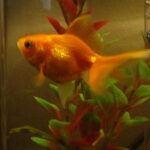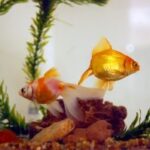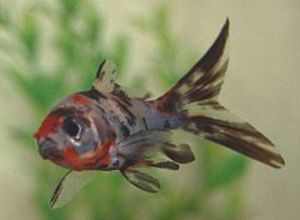Comet goldfish look like common goldfish, only they are sleeker and have a larger tail. They have become as common as common goldfish in the pet trade and are often sold as feeder fish. Those with spectacular coloration are singled out to be sold as pets and at a higher price. Some fish sold as comets will grow up to look more like common goldfish or a mixture of both. Comets can breed with some other strains of goldfish like the common goldfish.
Although considered a “cold water” fish, comet goldfish kept in aquariums should be provided with heaters to keep the water at about room temperature. Sudden changes in temperature can get a goldfish very ill or kill them. Ponds are not as subject to radical temperature changes as a small tank. Comet goldfish can grow to be fourteen inches long from nose to tail-tip, so they should not be kept in anything less than a ten gallon tank. However, many comets only stay at the three to four inche range and only grow if placed in a pond.
Community Fish
Comets get along with other comets, with common goldfish and with black moors. Comets are about the fastest swimmers in the goldfish world, so they should not live with slow swimming goldfish like lionheads, fantails or bubble-eyed goldfish. They will swim so fast that they will eat all of the food before the slower swimming fish have a chance to get to it.
If comets are placed in a pond with other goldfish and koi, they can also get along. However, fish that are a lot smaller than most of the usual pond fish population will be teased or even eaten by the other fish, so try to place only large comets in a pond that is already stocked with large fish.
Comets will also get along with suckermouth catfish or Plecostomus, but they can be harassed by these bottom-feeding fish, especially if they become ill. Although some goldfish care book claim that Corydoras catfish can get along with goldfish, usually common or comets will catfish, especially if the catfish is smaller than the goldfish. Some keepers of comet goldfish do not recommend keeping any bottom feeding fish with comets. Snails can get along with comets, but they breed incredibly fast and can take over a tank.
Colors
Comets can come in just about any color in the goldfish rainbow and breeders are striving to create even more colors. These colors include the standard orange-gold, metallic gold, metallic silver, canary yellow, white, orange and black, yellow and black, white and red and a white, blue, orange and black speckled combination often referred to as a Shubunkin.
Comets also change colors in the course of their lifetimes. This is why it’s not recommended to pick a fish for its color but by its general health because the color will most likely change over time. When comets are very young, they are often a metallic silver or bronze. This can then change to a yellow and black combination or to a solid orange-gold. Then, when the fish ages, this color may fade to white or a canary yellow.
Feeding
Comets are not fussy eaters but they do appreciate a little variety in their food, even if that means only switching from flake to pellet food every couple of days. They also enjoy frozen and freeze-dried blood worms and whiteworms. They also enjoy a bit of lettuce, provided it is clean and free of pesticides. They will also eat some of the algae growing in the tank.
Comets will eat themselves sick and so it they should only be fed enough food that they can polish off in two or three minutes. Breaking the feedings up throughout the day can also provide stimulation for the goldfish. All goldfish can learn to recognize their owners and will begin to actively beg and wriggle when it is time for them to be fed. Comets can twist and in a begging “dance” which can be spectacular to watch.
References:
“Goldfish: A Complete Pet Owner’s Manual.” Marshall E. Ostrow. Barron’s; 1985.
“Freshwater Aquariums for Dummies.” Maddy Hargrove & Mic Hargrove. Wiley Publishing; 2006.
“Goldfish.” Bernice Brewster & Nick Fletcher. Bow Tie Press; 2004.







